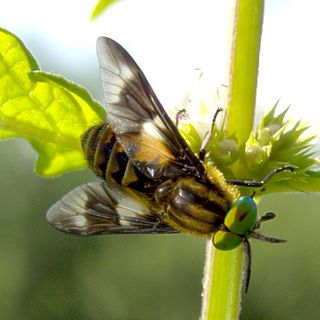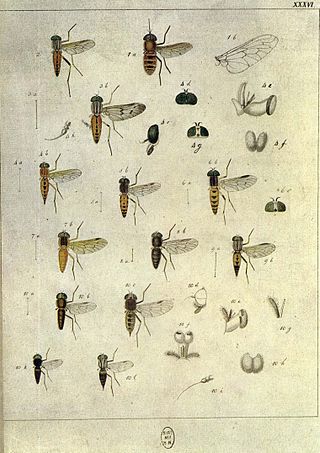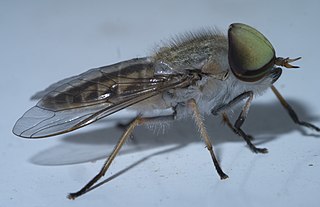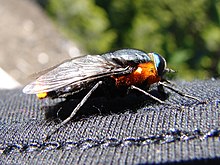
Superfamily Tabanoidea are insects in the order Diptera.

Pangonius is a genus within the horse-fly family (Tabanidae), often misspelled as Pangonia; Latreille originally published the name as Pangonius in 1802, emending it in 1804 to Pangonia, but the emendation is not valid under the International Code of Zoological Nomenclature. Some species that were earlier placed in this genus are now in the genus Philoliche.

Osca lata, the coliguacho or black horse fly, is a large horse fly whose range includes southern Chile and southern Argentina. The fly has a striking reddish-orange coloration on the side of its thorax and abdomen. It is generally around 2 cm. in adult size.

Scaptia is a genus of horse-fly in the tribe Scionini.

Dichelacera is a genus of horse flies in the family Tabanidae.

Tabaninae is a subfamily in the family Tabanidae commonly known as horse flies. There are more than 3000 described species in Tabaninae.

Diachlorini is a tribe of horse flies in the family Tabanidae.
Whitneyomyia is a genus of horse flies in the family Tabanidae. There is at least one described species in Whitneyomyia, W. beatifica.

Pangoniinae is a subfamily of horse-flies in the order Diptera, containing at seven tribes and over 40 genera.
Copidapha is a genus of flies in the family Tabanidae.
Scione is a genus of flies in the family Tabanidae.
Fidena is a genus of horse-fly in the tribe Scionini.
Rhabdotylus is a genus of horse flies in the family Tabanidae.
Pseudacanthocera is a genus of horse flies in the family Tabanidae.
Stypommisa is a genus of horse flies in the family Tabanidae.
Dicladocera is a genus of biting horseflies of the family Tabanidae.

Dasybasis is a genus of horse flies in the family Tabanidae.
Catachlorops is a genus of horse flies in the family Tabanidae.
Pseudoscione is a genus of flies in the family Tabanidae.










